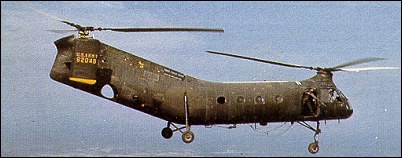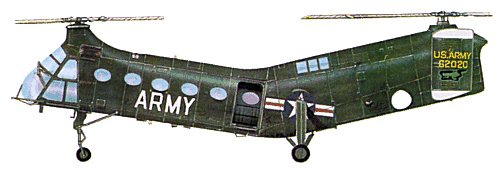
| Piasecki H-21 Workhorse / Shawnee 1953 |  |
 |

| Piasecki H-21 Workhorse / Shawnee 1953 |  |
 |
|
From the all-metal PV-17 built in 1948, the following year Piasecki derived the HRP-2 Rescuer and an improved version of the Rescuer, the H-21 Workhorse. The USAF acquired 214 of the latter, and 334 of a similar model, the H-21 Shawnee, were built for the US Army. The B and C variants of the H-21 were used in Vietnam, equipped with 12.7 or 7.62mm light machine guns which were fired through the cabin doors. The H-21 used the classic single engine formula with tandem three-blade rotors. While the Navy's helicopters had a 600hp Pratt & Whitney R-1340 engine, those for the Army had a Wright R-1820. Thirty-three of the H-21A were assigned to SAR units in the Arctic and another five were sent to Canada. Foreign operators of the H-21 included the German Army (26), French Army (98), French Navy (10), Japanese armed forces (10) and Swedish Navy (11). G.Apostolo "The Illustrated Encyclopedia of Helicopters", 1984  Developed from the US Navy's HRP-2, the Piasecki PD-22 tandem-rotor helicopter prototype (US Air Force designation XH-21) was first flown on 11 April 1952. Eighteen YH-21 helicopters had been ordered in 1949 for USAF evaluation, these being followed by an initial production batch of 32 H-21A helicopters, named Workhorse in USAF service. For use by the Military Air Transport Service Air Rescue Service, the H-21As were each powered by a derated 932kW Wright R-1820-103 engine; the first flew in October 1953. Six more were built to USAF contract but supplied to Canada under the Military Assistance Program. The second production variant was the H-21B, which used the full power of the 1063kW R-1820-103 to cover an increase in maximum take-off weight from 5216kg to 6804kg. Some 163 were built, mainly for Troop Carrier Command, and these had autopilots, could carry external auxiliary fuel tanks, and were provided with some protective armour. They could carry 20 troops in the assault role. The US Army's equivalent was the H-21C Shawnee, of which 334 were built. This total included 98 for the French army, 10 for the French navy and six for Canada; 32 Shawnees were supplied to West Germany, serving with the army's Heeresfliegerbataillon 300. The H-21C, redesignated CH-21C in July 1962, had an underfuselage sling hook for loads of up to 1814kg. Production deliveries were made between September 1954 and March 1959, later helicopters acquiring the company designation Model 43 when the Piasecki Helicopter Corporation became the Vertol Aircraft Corporation in 1956. The H-21 A and H-21B retrospectively became the Model 42. Two turboshaft conversions of H-21C airframes were the Model 71 (H-21D), with two General Electric T58 engines first flown in September 1957, and the Model 105 which had two Avco Lycoming T53s. From the latter was designed the Vertol 107 (Boeing Vertol H-46 series). D.Donald "The Complete Encyclopedia of World Aircraft", 1997
On April 11, 1952, the YH-21 Work Horse — Piasecki's best helicopter yet — took to the air with Len LaVassar and Marty Johnson at the controls. Winner of a USAF competition for an arctic transport helicopter, the new craft looked almost like the HRP-2, but weighed 6630kg fully loaded, more than twice the earlier machine. A 1425hp Wright R-1820 engine (derated in early models to 1150hp) and a 0.9m increase in rotor diameter to 13.4m gave it much better performance than the HRP-2. Structurally, it was a new aircraft. The company had come up with a winner. The Work Horse could carry fourteen fully equipped troops or an equivalent weight of cargo. Features included a rescue hoist and inflatable donut-shaped floats around its wheels for landings even on marshy tundra. Winterized to support Distant Early Warning (DEW) Line radar stations far to the north, it was just the aircraft the Air Force had wanted. Extensive cold-weather testing was performed atop Mount Washington, the highest peak in New Hampshire's beautiful White Mountains, as well as in the climate hangar at Eglin Air Force Base. J.P.Spencer "Whirlybirds: A History of the U.S. Helicopter Pioneers", 1998
In 1949 the U.S. Air Force ordered eighteen examples of the Piasecki Model PD-22 single-engined, tandem-motor helicopter for evaluation in the SAR and general transport roles. The YH-21 Work Horse, as the type was designated, made its maiden flight in April 1952. The Air Force was quite pleased with the YH-21, and eventually purchased thirty-two production H-21A SAR models and 163 of the more powerful H-21B assault transports. The Army became aware of the H-21's potential as a medium utility helicopter soon after the type's maiden flight, and in 1952 awarded Piasecki a contract for the production of the H-21C variant. This aircraft retained the H-21B's extensive armor plating and ability to carry two external fuel tanks, but had such additional features as increased troop capacity and a 4000-pound capacity belly sling hook. The Army procured 334 H-21C Shawnees, with deliveries beginning in August 1954. In addition, the Army obtained at least sixteen H-21B aircraft from the USAF; the majority of these machines were ultimately brought up to H-21C standard, and all were known as Shawnees despite their origins as Work Horses. The Army also funded Vertol's development of the XH-21D, which was essentially a standard H-21C whose single piston engine had been replaced by two General Electric T58 shaft turbines. Two H-21Cs were so modified and flight tested in 1957 and 1958, but the variant was not adopted for production. In 1962 the H-21B and H-21C were redesignated as, respectively, the CH-21B and CH-21C. Despite its rather ungainly appearance the H-21 Shawnee was a very capable and well-liked machine, and the type ultimately secured for itself a unique place in post-World War II Army aviation history. It was a Shawnee dubbed 'Amblin' Annie that made the first non-stop helicopter flight from one coast of the United States to the other, being refuelled in flight from a U-1A Otter. More significantly, the H-21 was the first American military helicopter type to be deployed in appreciable numbers to South Vietnam: the first four Shawnee units arrived in that country between December 1961 and September 1962. Inevitably, perhaps, the H-21 also gained the dubious distinction of being the aircraft in which America's first Vietnam casualties were killed; four Army aviators died in July 1962 when their Shawnee was shot down near the Laotian-Vietnamese border. The machine gun-equipped H-21s used in Vietnam were also, of necessity, the first American military helicopters to be fitted with door-mounted defensive weapons as a matter of course. Several additional aircraft were experimentally fitted with a variety of offensive weaponry and used as interim gunships pending the arrival in Southeast Asia of the first units of armed UH-1 Iroquois in the summer of 1963. The H-21 remained the backbone of the Army's aviation effort in South Vietnam until finally supplanted by the UH-1 in 1964, and most Shawnees were withdrawn from the active inventory within the following year. S.Harding "U.S.Army Aircraft since 1947", 1990
- A few examples of the civil Piasecki PD-22 (Vertol 44) served with New York Airlines and other carriers. - TYvo H-21Cs were re-engined with turboshafts, as XH-21Ds. - Foreign H-21 operators included West Germany, France and Canada. - Four US aviators killed in an H-21 In July 1962 are recognised by some sources as the first American fatalities in Vietnam. - The YH-21 prototype for this series made its maiden flight on 11 April 1952. - A total of 334 of these helicopters was produced for the United States Army.
|